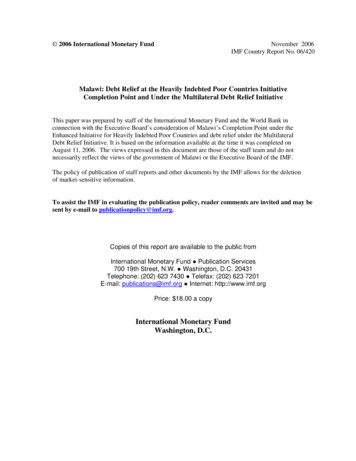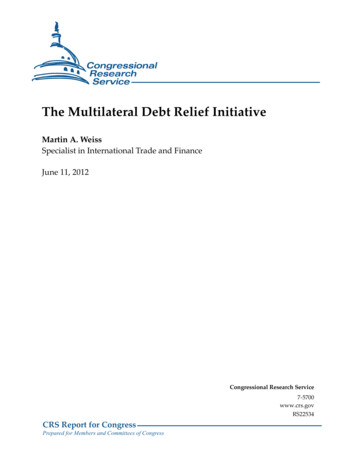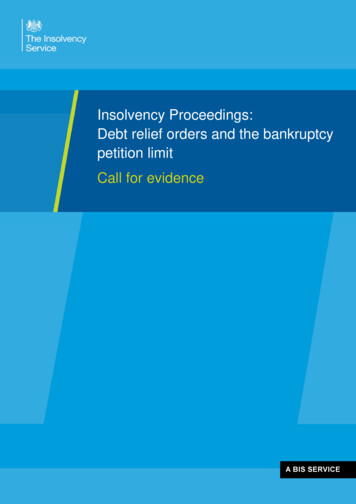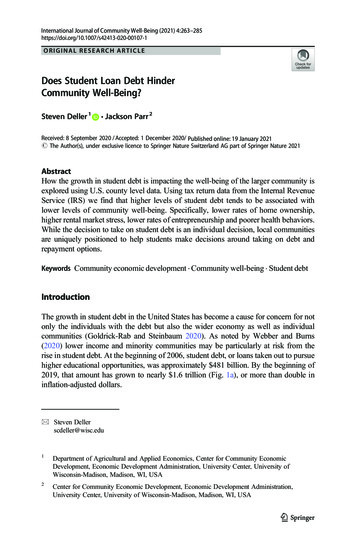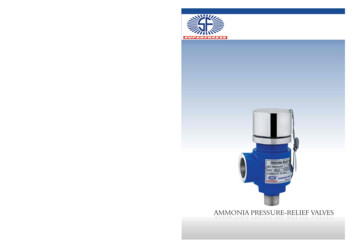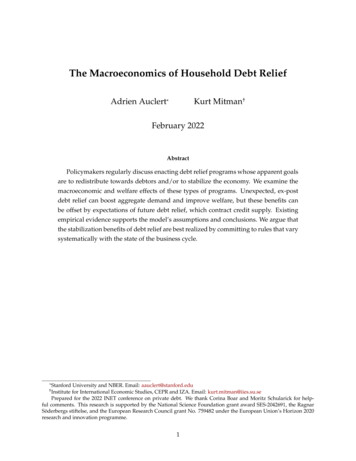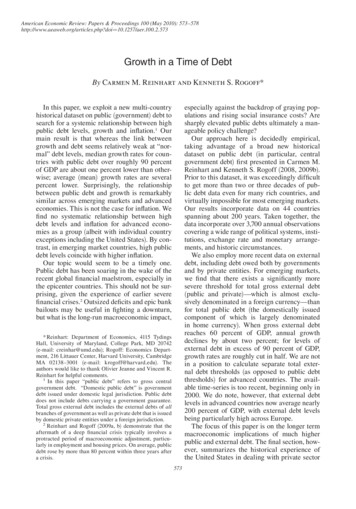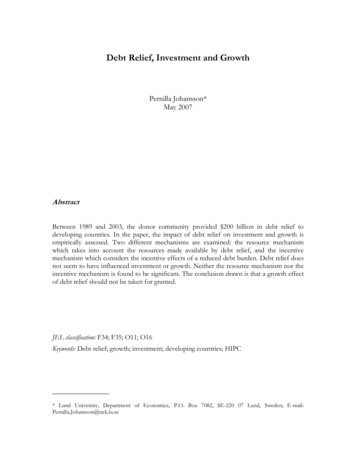
Transcription
Debt Relief, Investment and GrowthPernilla Johansson*May 2007AbstractBetween 1989 and 2003, the donor community provided 200 billion in debt relief todeveloping countries. In the paper, the impact of debt relief on investment and growth isempirically assessed. Two different mechanisms are examined: the resource mechanismwhich takes into account the resources made available by debt relief, and the incentivemechanism which considers the incentive effects of a reduced debt burden. Debt relief doesnot seem to have influenced investment or growth. Neither the resource mechanism nor theincentive mechanism is found to be significant. The conclusion drawn is that a growth effectof debt relief should not be taken for granted.JEL classification: F34; F35; O11; O16Keywords: Debt relief; growth; investment; developing countries; HIPC* Lund University, Department of Economics, P.O. Box 7082, SE-220 07 Lund, Sweden; E-mail:Pernilla.Johansson@nek.lu.se
1IntroductionDebt relief has rapidly gained importance as a policy tool over the past decade. The share ofdebt relief to aid has risen from an average of four percent in the 1990s to 22 percent in2005 in nominal terms (World Bank 2006). Between 1989 and 2003, the donor communityprovided 200 billion U.S. dollar as debt relief in nominal terms to developing countries.1Whereas bilateral debt relief has been provided through the Paris Club since the 1950s,multilateral debt relief is a recent phenomenon. In 1996, the World Bank and theInternational Monetary Fund launched the Heavily Indebted Poor Countries (HIPC)initiative, through which multilateral debt relief is granted. Following the request from theG-8 countries to extend the debt relief efforts to the world’s poorest and most indebtedcountries, the Multilateral Debt Relief Initiative (MDRI) took off in 2006. The measureshave attracted increasingly generous promises of funding from donors and are viewed asimportant growth enhancing and poverty reducing efforts.In spite of the growing importance of debt relief as a policy tool, few empirical studies assessthe growth effect, whereas the effect of aid has been extensively evaluated both withinacademic research and development institutions (see Roodman 2004 for an overview). Thisis somewhat surprising as aid and debt relief rely on distinct channels. While aid implies aflow of resources to the recipient country, debt relief makes resources available fromreduced debt service payments. In addition, debt relief reduces the debt stock which mightaffect incentives in the country. The debt overhang literature implies that debt relief spursgrowth in the recipient countries through improved incentives to invest and potential newcapital inflows (Krugman 1988 and Sachs 1989). In addition, the literature on the crowdingout theory implies that investment and growth are increased through released resources fromdebt relief (Cohen 1993). Another strand of the literature, however, argues that debt reliefdoes not enhance growth because of deficient institutions and the signalling effect ofrevealing an unsustainable debt (Bulow and Rogoff 1989, Bird and Milne 2003). Thesecontradictory theoretical outcomes leave the effect of debt relief on growth and investmentto an empirical question.The empirical research on how the stock of external debt affects growth provides mixedevidence. Some studies find a negative impact of debt on growth when the debt ratio reachesa certain threshold (Pattillo et al. 2004, Clements et al. 2003 and Pattillo et al. 2002), whileothers find evidence of a negative linear relation (Presbitero 2005). This suggests that debtrelief can spur growth in recipient countries by reducing the debt burden. Based on a growthand debt equation, Pattillo et al. (2002) predict that halving the debt of highly indebted poorcountries from the levels in 2000 would raise per capita growth by about one percentagepoint. Others reject any statistically significant effect of external debt on growth, indicatingthat debt relief might not enhance growth (see Dikjstra and Hermes 2001 for an overview).Few empirical studies explicitly assess the growth effect of debt relief. Depetris and Kraay(2005) study the effect of debt relief on growth and investment in low-income countriesbetween 1989 and 2003. They provide simple descriptive evidence of the relation, excludingcontrol variables from the analysis. They find no evidence of debt relief raising growth orinvestment rates among recipient countries. Similarly, Hepp (2005) does not find a general1Own calculations based on Global Development Finance 2005.1
effect of debt relief on growth judged from growth equations using annual data. However,he finds that countries that are not classified as HIPCs have benefited significantly from debtrelief.The purpose of this paper is to study the growth effect of debt relief in developing countries.It contributes to the emerging literature on the impact of debt relief and develops theprevious framework in various ways. The study allows for debt relief to affect growth troughtwo different mechanisms. The resource mechanism takes into account the resources madeavailable by debt relief, while the incentive mechanism considers the effects of a reduceddebt burden. Moreover, since the theoretical discussion emphasises the impact of debt reliefon growth through capital investment, the investment channel is explicitly assessed. Contraryto previous studies, the approach follows the growth and aid literature. A standard growthmodel and an accompanying investment equation are estimated using a generalised methodof moments estimator. The method yields consistent estimates in the presence of bothendogenous regressors and country specific effects. The data set used is a panel of 60 lowand middle-income countries2 with data averaged over four-year periods between 1989 and2003. World Development Indicators 2005 and the Global Development Finance 2005 arethe main data sources. The findings are not supportive of a growth effect of debt reliefneither regarding the incentive mechanism nor the resource mechanism. Neither a directeffect on growth nor an indirect effect thorough investment is evident in the data. Theresults hold when the implications of debt relief are allowed to be different in low- andmiddle-income countries.The paper proceeds as follows. In the next section, the concept of debt relief is presentedand an overview of its history is provided. In section three, the channels through which debtrelief might affect growth are discussed. Variables, data and estimation method areintroduced in section four. Section five presents the estimation results and section sixconcludes.Developing countries consist of low- and middle-income countries as defined by the World Bank. Lowincome countries are those in which 2004 GNI per capita was no more than 825; middle-income countries arethose in which GNI per capita was between 826 and 10,065 (WDI 2005).22
2Background2.1The Concept of Debt ReliefDebt relief includes any form of debt reorganisation that relieves the overall burden of debt.The three main types of reorganisation include debt rescheduling, debt forgiveness and debtconversion. Debt rescheduling is defined as a change in the terms and conditions of theamount owed. Alternatively, debt forgiveness involves a reduction in the amount of a debtobligation. A debt conversion is implemented when a creditor exchanges the debt claim forsomething of economic value other than another debt claim on the same debtor (IMF 2003).Two basic accounting identities can be used to illustrate the implications of debt relief: (2.1)the evolution of indebtedness and (2.2) the fiscal constraint of an individual debtor: D ( S P ) ( L W )G T L P A(2.1)(2.2)where D is the change in indebtedness, S is the contracted debt service payments,P is actual debt service payments, L is new borrowing, W is debt relief, G is non-debt relatedgovernment expenditure, T is tax receipts, and A is development aid from abroad.The direct impact of debt relief is a reduction of the debt stock.3 Although debt relief isrepresented by W, it is also possible that S is reduced. To fully account for the effect on thedebt stock, the terms of the loan has to be taken into account. The implication of debt reliefon non-debt related government expenditure arises through its impact on the actual debtservice payments and depends on the level of tax receipts, new borrowing and developmentaid from abroad. If a country, for example, has been in complete default for many years andnot been servicing any of its debts to a particular creditor, i.e. P 0, it would not be possiblefor any amount of debt relief to reduce further the cash payments actually being made by thedebtor. Still, debt relief reduces indebtedness in this case. On the other hand, if the recipientwas previously paying all contractual debt service, such that S P, then debt relief will relaxthe budget constraint to the full extent of the fall in S and reduce the debt burdencorrespondingly. More generally, conditioned on the level of tax receipts, new borrowingand development aid from abroad being equal, if P S, then the fiscal impact will be reducedaccordingly, and will only occur to the extent of the fall in P (Bird and Milne 2003).2.2History and StatisticsDebt relief is not a new phenomenon. Since the mid-1950s, the Paris Club has been aframework for rescheduling sovereign debt to bilateral creditors. In the 1970s and early1980s, a severe debt crisis developed, mainly in Latin American countries. Eight countrieshad to reschedule their debt payments in 1982 to escape the liquidity problems. Since theFor a debt rescheduling to reduce the debt stock, the rescheduling has to be made on more concessionalterms than the original loan.33
debt problems were also related to solvency, actions such as debt forgiveness wereintroduced (Daseking and Powell 2000). In the mid-1990s, debt relief became an importanttool for delivering development aid. Multilateral debt relief was considered for the first timein 1996, with the launch of the HIPC Initiative by the World Bank and the IMF. The linkbetween debt relief and poverty-reducing efforts was strengthened by providing relief underthe condition for the recipient country to develop a Poverty Reduction Strategy. Moreover,debt relief became closely linked to other aid-allocation decisions (Powell 2003). As of today,there are 40 eligible HIPCs, most of them in Sub-Saharan Africa.4 In 2006, multilateral debtrelief was again a priority on the development agenda with the decision to cancel the debt ofthe eighteen poorest countries in the world through the Multilateral Debt Relief Initiative.The debt of developing countries accrues to a large extent to official creditors, including anincreasing share provided by multilateral agencies. Whereas the share of the external debt ofdeveloping countries to official creditors has decreased since 1990, it has increased forHeavily Indebted Poor Countries (HIPCs). In 2003, about 90 percent of total external debtof HIPCs accrued to official creditors. The share of the official debt that is provided bymultilateral agencies has increased since the 1980s for HIPCs, as well as for developingcountries in general. In 2003, more than half of all official external loans to HIPCs wereprovided by multilateral creditors. Several developing countries experience a high debtburden, measured as the total external debt as a share of exports and as a share of GDP.Although the debt burden has decreased since the peak in the 1990sm the debt ratio is stillhigh, especially in HIPCs (see Appendix A).During the period between 1989 and 2003, debt relief to developing countries has beensubstantial with 200 billion U.S. dollars in nominal terms. The data also reveals that debtrelief does not consist of a one shot flow. On average, each country receives debt reliefabout five times during the period (see Appendix B). Although debt relief, in itself, reducesthe debt burden of developing countries, other factors influence the total change in theexternal debt stock of the countries. One important source of change is net flows on debt,including new borrowing. Moreover, cross-currency valuation effects arising frommovements in the value of the dollar against other world currencies show a significantimpact during the period (see Appendix A).4 To be part of the HIPC Initiative, a country must face an unsustainable debt situation after the fullimplementation of traditional debt relief mechanisms, be only eligible for highly concessional assistance fromthe International Development Association, establish a track record of reform, and develop a PovertyReduction Strategy Paper (See www.worldbank.org/hipc for more information).4
3Theoretical aspects on debt relief and growthThe theoretical effects of debt relief on growth are disputed. Proponents focus on twodifferent channels: the incentive mechanisms and the resource mechanism. On the otherhand, opponents question the existence of the both the incentive and resource mechanism,particularly in low-income countries. Also, one strand of the literature emphasises thesignalling effect of revealing an unsustainable debt.3.1The incentive mechanismThe argument that debt relief affects growth trough an incentive mechanism is based on thetheoretical literature that links a high debt to low growth. Increasing the level of debt mayhamper growth through the effects of debt overhang (Krugman 1988, Sachs 1989). A debtoverhang exists when a country’s debt exceeds its expected ability to repay, and expecteddebt service is likely to be an increasing function of the country’s output level. In this setting,creditors are the major beneficiaries from increased output while the total cost of economicadjustment accrues to the indebted country.According to the debt overhang theory, high debt affects growth through lower investmentvolumes as well as reduced efficiency of investments. Investment is discouraged in thedebtor country since part of the returns accrues to foreign creditors in the form of debtservice. High future debt service is viewed as an implicit tax on investment, which dampensinvestment efforts. Debt overhang makes it also more difficult to obtain credit forinvestment efforts. Moreover, in a high debt environment, the uncertainty about the actionsand policies of the government to meet its debt service obligations increases. The literatureon investment under uncertainty emphasises that in highly uncertain and unstableenvironments, investors are reluctant to invest in costly, irreversibly projects (Servén 1997).As in other high uncertainty environments, investments that do take place in high debtenvironments will likely be in trading activities with quick returns, rather than long-term,high-risk investment. This misallocation of investment will lower the efficiency of overallcapital accumulation, suggesting that high levels of debt and associated uncertainty mightaffect growth also via investment efficiency and productivity (Pattillo et al. 2002). In sum, acountry suffering from debt overhang is unable to service its debt, to obtain new loans andto invest as much or as efficient as it otherwise would.When a country suffers from debt overhang, debt relief can improve economic efficiency.By reducing the stock of debt, debt relief reduces the implicit tax on investment and possiblyreduces uncertainty.5 This is assumed to reinstate the incentive for the country to undertakeefficient investments and for new lenders to extend credit. Hence, growth can be enhancedthrough increased volumes of investment and higher productivity growth. Taken together,the incentive mechanism can be summarised in the following hypothesis:Krugman (1988) shows that debt relief can make the creditor better of as well if it increases the likelihood thatthe debtor will repay what remains of the loan.55
Hypothesis 1: Debt relief increases growth, through higher investment volumes as well as increased efficiency ofinvestments, in the case of a high debt burden.3.2The resource mechanismThe resource mechanism draws upon the crowding-out theory (Cohen 1993). In the case ofa high debt burden, debt service payments crowd out investment and thereby impedegrowth. In this setting, debt relief might affect investment and growth through an expansionin public spending by easing the government’s budget constraint. As can be seen fromaccounting identity (2.2), for debt relief to actually generate resources and easing thegovernment’s budget constraint, some premises need to be fulfilled. Resources are only freedif the country has actually been servicing its debt (P) and if the revenue collection in thecountry is not reduced (T). Moreover, debt relief has to be provided in addition to aid (A)(Bird and Milne 2003).The channels through which resources from aid, in the form of budget support, and releasedresources from debt relief affect growth are assumed to be identical. As in the case of aid,debt relief is supposed to increase growth by providing resources that could be used forproductive investments. Dalgaard et al. (2004) present theoretical aspects within a twoperiod Diamond model. They show how transfers improve steady state productivity byraising the capital stock per person. The resource mechanism argument can be summarisedas follows:Hypothesis 2: Debt relief increases growth by freeing resources that are used for productive investments.3.3Contrasting theoretical aspectsThere is disagreement on the implications of debt relief, particularly regarding theconsequences in low-income countries. The debt overhang model, which lays the foundationfor the incentive mechanism, is designed for countries that suffer from heavy debt burdensunder non-concessional private debt. However, the debt burden of the heavily indebtedcountries of today consists mainly of official and concessional debt.6 Official debt onlygenerates a debt overhang if higher levels of debt stock mean that debtors anticipate lowerlevels of net resource transfers in the future.7 Bird and Milne (2003) show that higher levelsof outstanding debt are associated with higher levels of net resource transfers from officialsources. The implication is that a high debt burden does not limit the access to new capitalinflows in these circumstances. Moreover, the investment channel, which plays a central rolein models of debt overhang, is argued to be absent in low-income countries (Arslanalp andHenry 2004). For debt overhang to discourage investment, the country must have a privatesector with potential investment projects to discourage. This is argued not to be the case inmany low-income countries due to the absence of functional economic institutions. Withoutfoundations for profitable economic activity, it is not likely that debt relief will stimulateforeign capital inflows, investment and growth in heavily indebted poor countries (Arslanalp67See Appendix A for figures.Net resource flows are defined as new borrowing and development grants less debt service.6
and Henry 2004). Koeda (2006) develops a theoretical model of how debt overhang could begenerated in low-income countries. The implication is that a one-time debt stock treatmentmight enhance growth depending on the country’s initial conditions. However, debt reliefdoes not consist of a one shot treatment.8 This leaves the effect of debt relief to an empiricalquestion.Bird and Milne (2003) emphasise the unimportance of the resource mechanism in heavilyindebted countries. Despite the debt service obligations, these countries receive more capital,in the form of loans and grants, than they pay out to their creditors. Inflows of officialresources net of debt service payments are substantial and positive for virtually all theseverely indebted low-income countries (Bird and Milne 2003). The implication is that debtrelief could only have a minimal impact on net resource transfers, and a growth enhancingeffect through the resource mechanism is therefore not expected.One strand of the literature emphasises that the signalling effect of debt relief might have adetrimental effect mainly in middle-income countries. In the debt literature, reputationmodels are developed to explain enforcement mechanisms. Since debtors find it painful tobe excluded from future credit markets, they are assumed to avoid defaulting (see forexample Eaton and Gersovitz 1981 and Bulow and Rogoff 1989). Whereas the debtoverhang literature assumes that a reduced debt stock pave the way to new lending, thereputation literature emphasises that rewriting debt contracts may hurt a debtor’s reputationand hinder its ability to obtain future loans (Easterly 2002). Moreover, debt relief couldintensify uncertainty about actions of the government to meet its debt service obligations inthe future. The investment under uncertainty literature predicts that this dampensinvestment efforts in the country (Servén 1997). The result is that countries receiving debtrelief do not attract new investments or capital and growth is not enhanced. Taken together,debt relief is not expected to enhance growth in neither low- nor middle-income countries.The contrasting theoretical aspects can be summarised as:Hypothesis 3: Debt relief does not increase growth or investment, neither through the incentive nor the resourcemechanism.8See Appendix B for figures.7
4Data and empirical modelThe purpose of the empirical investigation is to estimate the effect of debt relief on growth.As discussed above, the investment channel is emphasised both regarding the incentive andthe resource mechanism, and the channel is therefore analysed explicitly. In line withprevious literature, the relationships are estimated separately using a growth model and aninvestment model (Barro 1999, Borensztein et al. 1998, Hansen and Tarp 2001). The growthmodel follows the basic empirical set-up in Barro (1991), augmenting the specification byadding debt and aid variables. The framework combines basic features of the neoclassicalgrowth model – especially conditional convergence which suggests that poor economiestend to catch up with rich ones – with extensions that emphasise the role of governmentpolicies and institutions. The investment equation is estimated within the same framework,the difference being the treatment of investment as the dependent variable.Observations cover the period from 1989 to 2003. Data on debt relief is available from 1989,thereby restricting the estimation period. World Development Indicators (WDI) 2005 andthe Global Development Finance (GDF) 2005 are the main data sources. The entire sampleconsists of all low- and middle-income countries that are available in the GDF database,which in total accounts to 136 countries. The panel used in the analysis is unbalanced withdata for at least one period for 60 countries, of which 19 are HIPCs. Countries included inthe empirical analysis are listed in Appendix C. To avoid short run cyclical movements, thesample is divided into four-year-periods, which is the general convention in the aideffectiveness literature.9 The last period includes 3 years; however, for expositional simplicityit is throughout denoted four-year-periods.4.1Data and variablesTwo different dependent variables are applied in the analysis. In the investment model, grosscapital formation as a percentage of GDP is used.10 Hence, the specification allows anassessment of the effect of debt relief on the volume of investment. In the growth equation,the average real per capita GDP growth is treated as the dependent variable. Growth iscalculated as the annual average growth rate for each four-year-period.11 Appendix Dprovides details of the variables used and their sources.4.1.2Debt relief variablesIt is not obvious how to measure debt relief. When the interest lies in measuring the impactof debt relief in the receiving country it is important to take the impact on the debt burdenas well as the released resources into account. As the theoretical section illustrates, a reduceddebt burden can affect investment and growth through the incentive mechanism, while thereleased resources might influence through the resource mechanism. The nominal variablesThe sub-periods are 1989-1992, 1993-1996, 1997-2000 and 2001-2003.The variable is calculated as an average for each four-year-period. When data is missing, averages for nonmissing data are used. This method is applied to all variables that are treated as averages.91011growth (( gdpt 3 gdpt ) / gdpt ) / 48
of debt relief available in the GDF database do not capture these characteristics.12 Therefore,two measures of debt relief are calculated to capture the different mechanisms. Thefollowing section provides a presentation of the two measures, while a more detaileddescription is provided in appendix.The change in the debt stock is captured by calculating a present value measure of debt relief(pvdr). A present value reflects the degree of concessionality of loans and thus morecorrectly measures the change in the expected burden of the debt.13 It is of particularimportance to use the present value measure in developing countries, since a significantfraction of their loans is on concessional terms.14 However, there exist no internationalstatistical standards on how to measure debt relief in present value terms. Depetris andKraay (2005) provide a first attempt, and their approach is closely followed here. In short,the calculation is based on the assumption that the concessionality rate of the debt forgivenor rescheduled equals the concessionality rate of the debt stock in the country. Since thepresent value measure of debt relief captures the change in the debt stock, it corresponds tothe incentive mechanism. Turning to the resources freed by debt relief, the nominal variableof debt relief needs to be adjusted to reflect whether the debt was likely to be serviced ornot. A market value of debt relief (mvdr) is calculated to capture this mechanism.15 Themarket value takes into account the previous debt service situation, thus reflecting theresources actually released by debt relief. Since the loans of most countries in the sample arenot traded on the secondary market, the market value has to be estimated. Following Cohen(2000), the value is calculated building upon econometric evidence of the relationshipbetween the secondary market prices and the debt stock, arrears and reschedulingcommitments of middle-income debtors during the 1980s. The market value of debt reliefcorresponds to the resource mechanism. See Appendix E for a more detailed description ofthe two measures of debt relief.Figures for the two different measures of debt relief are presented in Table 4.1. Since thepresent value of debt relief is discounted to the beginning of each four-year-period andaggregated, while the market value of debt relief is expressed as the average over the period,the magnitudes are not comparable. Debt relief has been sizeable and it has been spread overthe entire sample period. However, the magnitude has gradually decreased as a percentage ofGDP since the first period. When the sample is divided into low- and middle-incomecountries, it is apparent that low-income countries received more debt relief than middleincome countries. Moreover, HIPCs received considerable higher amounts of debt reliefcompared to non-HIPCs.Depetris and Kraay (2005) provide a thorough discussion of the problems related to the available data.The present value of debt is defined as “the discounted sum of all future debt service at a given rate ofinterest” (IMF 2003, p. 264). The concessionality rate is the present value of the debt expressed as a percentageof the nominal value (ibid, p. 250). A loan is concessional if it is extended on terms more generous than marketterms.14 See figures of the concessionality rate of loans in Appendix A.15 The measure tries to capture the reduction in actual debt service paymants (P) in contrast to contractual debtservice payments (S).12139
Table 4.1 Measures of debt relief, bt relief ratio (pvdr)4.2%5.9%3.0%3.1%Low-income countries5.2%10.1%5.9%6.6%Middle-income -HIPCaDebt relief ratio (mvdr)2.3%1.6%1.2%0.3%Total sample1.2%1.1%0.7%0.6%Low-income countriesMiddle-income IPC2.1%0.8%2.0%0.8%1.1%0.5%1.7%0.2%Total sampleaExpressed in percentage of GDP4.1.2Additional variablesThe debt stock is included in the analysis to capture the effect of a high debt burden oninvestment and growth. The initial present value of the long-term public external debt stockis used (Dikhanov 2006). To assess the significance of development aid, other than debtrelief, the regressions include Effective Development Assistance, EDA (Chang et al. 1998).EDA includes grants and disbursements of all development loans regardless of howconcessional they are, but counts only their grant element. EDA is a relevant measure in thestudy since official financial flows in the form of loans are measured in accordance with thedebt literature and, in particular, because debt relief is excluded.16 Following previous studieson aid effectiveness, aid squared is also included to capture the assumed diminishing returnsof aid (Hansen and Tarp 2001, Lensink and White 2001).Control variables are included in the regressions to capture the effect on investment andgrowth of other variables than debt relief, the debt stock and aid. The same variables areused in the investment and growth regressions (Borensztein et al. 1998, Barro 1999). Thepresentation of the variables focuses, however, on the growth model. Conditionalconvergence implies that poor countries catch up with rich countries once factors such ashuman and physical capital are taken into account (Barro and Sala-i-Martin 1992, Mankiw etal. 1992). Real GDP per ca
In the mid-1990s, debt relief became an important tool for delivering development aid. Multilateral debt relief was considered for the first time in 1996, with the launch of the HIPC Initiative by the World Bank and the IMF. The link between debt relief and poverty-reducing efforts was strengthened by providing relief under
